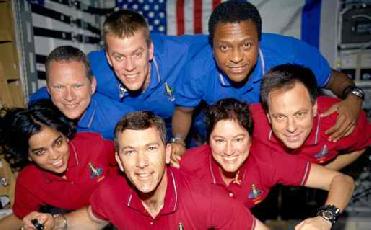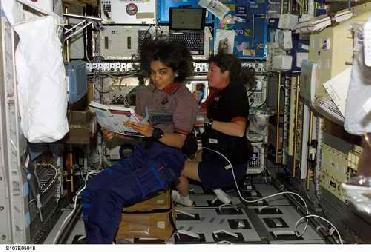
A file photo of NASA's shuttle Columbia crew who perished in a crash over Texas on February 1, 2003, all seven-crew members including Indian Kalpana Chawla (first from left) died in the accident. Photo from columbiashuttlefund.com
WASHINGTON, DC (BNS): NASA on Tuesday issued the detailed report on "Columbia Crew Survival Investigation Report", with several recommendations for better response from space crew in case of emergencies. The report also details the last moments of the ill-fated Columbia flight on February 1, 2003, when it disintegrated over Texas during descend, killing all its seven crew members including Indian-born Kalpana Chawla.
The Columbia tragedy happened after a large piece of insulating foam from Columbia's external tank had come off during ascent and struck the leading edge of the left wing, causing critical damage. The damage was undetected during the mission.
Tuesday's report has suggested that future space shuttle crew training should include greater emphasis on the transition between problem-solving and survival operations. All future spacecraft must "fully integrate suit operations into the design of the vehicle and provide features that will protect the crew without hindering normal operations," the report has said.
The report has also pointed out lacunae in the design of helmets shoulder harnesses. "When the orbiter lost control, the resultant motion was not lethal but did require crew members to brace against the motion. The forebody, which is made up of the crew module and forward fuselage, separated at orbiter breakup. The forebody continued to rotate. After the crew lost consciousness due to the loss of cabin pressure, the seat inertial reel mechanisms on the crews' shoulder harnesses did not lock. As a result, the unconscious or deceased crew was exposed to cyclical rotational motion while restrained only at the lower body. Crew helmets do not conform to the head. Consequently, lethal trauma occurred to the unconscious or deceased crew due to the lack of upper body support and restraint," the report said.
"Future spacecraft should be evaluated for loss of control motion and dynamics for adequate integration into development, design, and crew training. Future spacecraft seats and suits should be integrated to ensure proper restraint of the crew in off nominal situations while not affecting operational performance. Future crewed spacecraft vehicle design should account for vehicle loss of control to maximize the probability of crew survival," the report has said.
Future vehicle design should "incorporate an analysis for loss of control/breakup to optimize for the most graceful degradation of vehicle systems and structure to enhance chances for crew survival." The ascent and entry suit system is certified to a maximum altitude of 100,000 feet and velocity of 560 knots equivalent air speed. "It is uncertain whether it can protect a crew member at higher altitudes and air speeds," the report said.
The ascent and entry suit system provides protection from ground impact with a parachute system. But the current parachute system requires "manual action by a crew member to activate the opening sequence." The Columbia crew had no time for such a response, according to the report. So, future spacecraft crew "survival systems should not rely on manual activation to protect the crew."
The report goes into details about the last moments of the shuttle. "The Columbia depressurization event occurred so rapidly that the crew members were incapacitated within seconds, before they could configure the suit for full protection from loss of cabin pressure. Although circulatory systems functioned for a brief time, the effects of the depressurization were severe enough that the crew could not have regained consciousness. This event was lethal to the crew," the report said. The crew had just about a minute to react
 Next Article
Next Article













The Indian Air Force, in its flight trials evaluation report submitted before the Defence Ministry l..
view articleAn insight into the Medium Multi-Role Combat Aircraft competition...
view articleSky enthusiasts can now spot the International Space Station (ISS) commanded by Indian-American astr..
view article